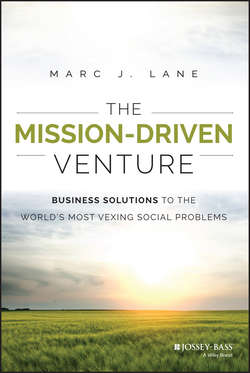The Mission-Driven Venture

Реклама. ООО «ЛитРес», ИНН: 7719571260.
Оглавление
Lane Marc J.. The Mission-Driven Venture
Preface
Acknowledgments
About the Author
About the Website
Chapter 1. Nothing Stops a Bullet Like a Job
“Father G” and Homeboy
Vanessa Bartram and WorkSquare, LLC
The Origin of Mission-Driven Ventures
Businesses Drive Social Change
Profits and Purpose
Our Agenda
Chapter 2. Where to Begin? Constructing the Mission-Driven Venture
Maximizing the Prospects of Financial Success and Meaningful Social Impact
Tracking Input, Output, and Outcome Indicators
Entity Design Choices
Moving from Ideation to Realization
Preparing for Launch
Zeroing in on Size and Scale
Chapter 3. Communities of Interest Benefit Corporations and Certified B Corps
Delaware Rejects Stakeholderism
The Benefit Corporation's Impact
Delaware, the Outlier
Patagonia's Values and Vision
Public Good Software Supports Civil Society
Ensuring Accountability to Stakeholders
Chapter 4. PRIs and L3Cs
The Low-Profit Limited Liability Company (L3C)
The “Sustainability Mayor” Leverages His Impact
Counseling Data, L3C: A Case Study in Collective Impact
Chapter 5. The Poor and Their Banker Lead the Way
Professor Yunus' Journey
The Visit to Jobra
The Banking System's Failure
Yunus' Ingenious Solution
The Advent of the “Social Business”
Grameen Bank and Its Strategy
Chapter 6. Leveraging Grameen
The Power of Cause-Related Marketing
The Grameen Family Expands
Social Venture Franchising
Grameen Empowers Entrepreneurs
Chapter 7. The Mondragón Miracle Scaling the Peaks Beyond the Pyrenees
Italy's “Social Co-Operatives”
France's “SCOP”
Why Worker-Owned Co-Ops Succeed
The Evergreen Cooperatives Build on MondragÓn's Success
Chapter 8. Social Impact Bonds Aligning Financial and Social Returns
Funding Targeted Intervention Strategies
“Pay for Success”
The Massachusetts Initiative
New York City Leads the Way
Pay for Success Gains Traction
Where Social Impact Bonds Work
The Social Impact Bond's Progeny
Empowering the Social Sector
Chapter 9. Building and Rebuilding Communities
Donor-Advised Funds
The Role Foundations Play
Lessons Learned
Chapter 10. Investing for Impact
The Origin of Impact Investing
Impact Investing Takes Root
Chapter 11. How Impact Investing Works – and Why
The Form of the Investment
Managing Risk
Judging Investment Performance
Quantifying Social Returns
Cashing Out
The Challenges of an Impact Investing Market
Chapter 12. Impact Investing Pursuing Its Destiny
The Importance of Public Policy
The Institutional Investors Weigh In
The Growth Trajectory Is Clear
Chapter 13. Keeping Score What Success Looks Like
A Safe Haven's Social Impact
Crediting the Causes of Positive Social Change
REDF and Social Return on Investment
Root Capital and Its “Social and Environmental Scorecard”
Acumen Fund and Its “Best Alternative Charitable Option”
Chapter 14. Answering the Call The Demand for Social Metrics
Scaling Success
Shared-Outcomes Networks
Chapter 15. Toward a Universal Metrics Language
Creating More Social Good
The Industry Steps Up
Impact Reporting and Investment Standards (IRIS)
The Global Impact Investing Rating System (GIIRS)
B Analytics
Other “Universal” Standards
The World Takes Note
Chapter 16. What the Future May Hold The Triumph of the Mission-Driven Venture
The Poorest of the Poor Have Reason for Hope
The Growing Role of Business
Social Enterprise Gains Influence in the Developing World
Business Raises the Bar
Governments Reach Out to Mission-Driven Ventures
Measurement of Social Performance Becomes More Sophisticated
Stakeholders Look to Substance Over Form
Social Capital Takes Center Stage
The Stakes Go Higher
Collaboration Becomes the Watchword
Index
Отрывок из книги
Governments and nonprofit organizations everywhere have compassionately invested billions in social services, yet, wherever we look, we still face stubborn challenges in education, health care, poverty, unemployment, and the environment. Those challenges are tougher than ever: the world has not yet recovered from unprecedented economic shocks, government spending is unsustainable, and charitable resources are inadequate to fund the deepening problems too many face. While public- and social-sector programming has improved the lives of countless people, so, increasingly, have market-based business initiatives.
Alone and in combination with government and philanthropic efforts, business strategies are effectively addressing the most intractable of social problems. For-profit, social-purpose businesses are defining success in terms of both financial and social returns. Nonprofits are becoming entrepreneurial, supplementing charitable donations and government grants with revenue earned by the businesses they own and run, instrumentalities of mission in their own right. Progressive nonprofits are partnering with each other, and even with for-profits, breaking down cultural barriers, leveraging their competencies, and gaining economies of scale.
.....
But it's not only profitability that motivates these corporations to adopt socially responsible practices. It's also the belief that for-profit businesses can be a force for economic and social good, more so perhaps than any other economic sector.
Consider, for example, the TATA Group, India's largest private employer, whose more than eighty companies employ 200,000 people in steel, automobile, software, consumer goods, and telecommunications ventures. About two-thirds of the equity capital of the company's parent firm, Tata Sons Ltd., is held by philanthropic trusts established in the 1860s. The TATA Group's founder, Jamsetji Nusserwanji, noted long ago that “in a free enterprise, the community is not just another stakeholder in business but is in fact the very purpose of its existence.” Decades later, Manoj Chakravati, another corporate officer, framed the company's mission this way: “Corporate Social Responsibility should be in the DNA of every organization. Our processes should be aligned so as to benefit the society. If society prospers, so shall the organization…”
.....